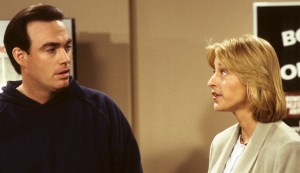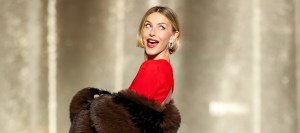Masks have long been a staple of theater, dating all the way back to ancient Greece and the birth of theater. At that time, the exaggerated expressions of various masks could help convey a character and their emotions in a massive theater, instantly expressing the stakes of a scene to thousands of onlookers.
The art of exaggeration continued with the advancement of cinema, as German expressionist films of the early 20th century used similar concepts of exaggeration to evoke a bigger reaction from its audiences, as they were witnessing moods that were heightened far past reality.
Videos by PopCulture.com
Masks have become a staple of horror films in a variety ways. In some instances, a killer might adorn a mask to disguise their identity while carrying out their nefarious plans. In other instances, a mask becomes an impromptu visage of terror when a character attempts to hide a horrible disfigurement.
Regardless of the reason, masks have become an iconic part of pop culture, thanks to the strong emotional reactions they’re created through use in horror films.
Scroll down to check out our picks of some of the best horror movie masks of all time!
Eyes Without A Face (1960)

Following a terrible automobile accident, an ambitious and experimental doctor aims to repair the damage caused to his daughter’s face, leaving her horribly disfigured. Through his various attempts to heal his daughter, he performs experiments on young women in hopes of stealing their face to graft onto his daughter’s.
Through the film, the daughter wears a human-like mask, which is completely devoid of any human emotion. The only element of humanity that shines through is the character’s eyes, hence the name of the film.
Eyes Without A Face is undeniably a horror movie, but one of the more horrific elements, that of the daughter’s mask, is something that’s only barely connected to the horrors depicted on screen. Instead, the mask removes her humanity almost completely, contradicting the previous uses of masks and their abilities to heighten the emotions of the wearer.
The mask in this film might not immediately make you fear for your life, but the lack of humanity causes an instant feeling of creepiness.
The Wicker Man (1973)

After receiving a distressing letter about a missing girl on a remote island, a very religious investigator heads to the island community in hopes of discovering the whereabouts of the young girl. During his investigation, the repressed police officer has his faith tested while witnessing the sex-positive rituals carried out by the residents of the island.
Struggling to determine a connection between the promiscuous nature of the community and the disappearance of the young girl, the investigator discovers a connection between human sacrifice and the success of an annual harvest.
Similar to Eyes Without A Face, the effectiveness of the masks used in The Wicker Man lay in their ability to strip wearers of their humanity. Rather than a human-like mask, however, the film uses a variety of animal masks to convey a surreal atmosphere that permeates the entire film, expressing how, by embracing their more primal and animalistic nature, the island’s residents could be capable of carrying out some horrifying activities that a sophisticated society wouldn’t stand for.
The Texas Chain Saw Massacre (1974)

When a weary group of friends attempts to investigate who has been vandalizing their grandfather’s remains, the individuals enter a living nightmare after encountering the deadly and cannibalistic Sawyer family.
Based on initial appearances, Leatherface emerged in Texas Chain Saw Massacre as a massive figure wearing a decrepit old mask, bashing someone on the head with a hammer and dragging a woman away to her doom with ease. The character got exponentially creepier at the reveal that his masks were created by sewing the faces of his victims into masks, allowing him to embody anyone he wanted in hopes of covering up his facial deformities.
Throughout the film’s many sequels, Leatherface has worn all styles of mask, men and women, young and old, without providing one standout visage. The character’s focus on quantity over quality is what has made each and every one of his masks creepier than the last.
The Town That Dreaded Sundown (1976)

Inspired by true events, The Town That Dreaded Sundown tells that tale of the “Phantom Killer” that plagued Texarkana, TX, a rural town on the border of Texas and Arkansas, whose bureaucratic complications impeded the pursuit of a killer.
In the ’40s, multiple teens were murdered by a man wearing a burlap sack with holes cut for eyes, resulting in the possibility of any number of suspects. The brutality of the murders were varied, with some victims being killed relatively swiftly while others were tortured and disfigured.
Yet again, simplicity is the strength of the mask in this film, as anyone could potentially craft a mask as simple as the one featured in the film. The concept has been recycled a variety of times, including The Strangers, The Orphanage and the Friday the 13th franchise all adopting a similar look, but they all have The Town That Dreaded Sundown to thank for the inspiration.
Halloween (1978)

On Halloween night in a small town in Illinois, a young Michael Myers murders his older sister, forcing him to be locked up in a mental health facility. Years later, a now-adult Michael returns to his town to continue killing coeds with no seeming rhyme or reason.
In addition to the violent crimes unfolding n Haddonfield, IL, a local hardware store is robbed of supplies one would use to help murder people, as well as a mask. While the mask of the killer isn’t immediately recognizable, the visage is well-known for originally being a mask of William Shatner that was painted and modified to create the look of Michael Myers.
The effect of the mask in the film is incredibly effective, but what ultimately makes Halloween a success is the idea that, on Halloween night, you don’t know who you can trust. With the amount of people who get dressed up as someone else, whether their new look is more playful or more sinister, the person under the mask’s motivations could be virtually anything, including an escaped mental patient who is wreaking havoc in his old stomping grounds.
Friday the 13th (1980)

Camp Crystal Lake closed down after a camper accidentally drowned in the lake, but years later, a new group of counselors hopes to revive the camp to all its glory. Unfortunately, a mysterious killer lurks in the woods that wants the camp to stay closed, picking off counselors one-by-one.
The most iconic image from Friday the 13th is that of Jason Voorhees wearing a hockey mask, an image that didn’t debut until the third film. The villain of the first film is Jason’s mom and Jason dons a burlap bag in the second film, but the formula was perfected when the killer snagged a goalie mask for the series’ 3D installment.
Only once did the iconic hockey mask get a facelift, when Jason X featured a machine that used cybernetics in some capacity to rebuild anything that was damaged. As it took place in the future and featured a very beat up Jason and mask, the character got a cutting-edge makeover which failed to impress fans.
Halloween III: Season of the Witch (1982)

In a move that shocked virtually everyone, the Halloween series decided to move away from the legend of Michael Myers and pursue an all-new angle of what could make Halloween scary.
After a man turns up at a hospital with fatal injuries clutching a novelty mask, a doctor at the hospital investigates the novelty’s origins. Visiting a small town in northern California, the doctor learns that the whole town thrives thanks to the owner of the mask manufacturer, but he harbors a deep secret. Once the doctor infiltrates the facility, he discovers the masks themselves contain powerful properties, killing anyone who wears one while a specific jingle plays through the TV.
Halloween III: Season of the Witch doesn’t strike fear into the hearts of the audience as effectively as the first film in the series, but still manages to tie into other fears. It could be argued that the film has undertones about the culture of consumerism, but it also delivers a spooky Halloween tale that gave audiences memorable witch, skull and jack-o-lantern masks.
Nightbreed (1990)

The ’80s were the hey-day of masked killers lurking coeds to violently kill them off, with the ’90s bringing in far more ambitious fare that included science fiction, psychological thrillers and frightening fantasies.
Written and directed by Hellraiser creator Clive Barker, Nightbreed depicts a man imprisoned in a mental health facility who overhears another patient describing a mythical realm known as “Midian.” While the man is killed shortly after discovering this realm, an encounter with one of the monsters of Midian results in the man coming back to life, allowing him to seek justice for his murder.
A key component of the narrative is that the doctor who gets the man locked in a facility accomplishes this by blaming a series of murders on the patient, which the doctor himself is actually guilty of. During his violent acts, the doctor dons a disturbing modification of the burlap sack that grew ever-so-popular in the horror movie world, with added zippers and buttons that added a dark and fantastical tweak on the core concept.
Scream (1996)

In more ways than one, Scream helped revive the slasher genre that had grown stagnant by the early ’90s, including the mask worn by the film’s killers.
Following the brutally violent murders of two of the high school’s most popular students, the local police force of a small town is left with no leads, as the killer wore an outfit that was easily purchased at virtually any Halloween store. Over the course of the film, we learn that it wasn’t just one killer but two teens working together to terrorize the community, as their horror movie obsession and quest for vengeance had motivated their murder sprees.
The ’80s birthed killers with iconic looks, but Scream went the opposite direction in its use of an easily-obtainable outfit. In addition to the effect this had on audiences, the choice of costume made sense in the narrative, as it allowed multiple people to embody the creepy presence.
You’re Next (2013)

Throughout the ’00s, the world of horror focused far more on gruesome violence and special effects instead of crafting an iconic look of a killer, something that You’re Next aimed to fix.
To celebrate a mother and father’s anniversary, a family reunites at a remote house in the woods for an impromptu reunion. As the family’s tension with one another begins to peak, a group of killers descends upon the house for unknown reasons. Considering the success of the family’s patriarch, it becomes clear that money was a motivating factor in the burglary, but unwrapping that enigma is only one answer to the violent ordeal.
The You’re Next filmmakers have revealed that, when crafting the look of the characters, they took inspiration from other greats in the genre. One of these influences was Wicker Man, which explains why the trio of killers used lamb, tiger and wolf masks to hide their identities. Another inspiration came from 2008’s The Strangers, which utilized store-bought masks and a burlap sack, leaning on accessibility to make that film’s ordeal more terrifying.
The combination of these influences proved effective, as the masks in You’re Next might go down as the most intimidating horror movie masks of the decade.








